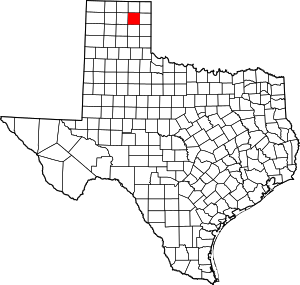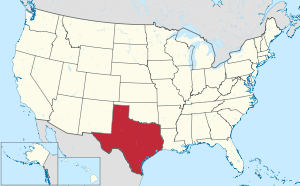Roberts County, Texas
Roberts County is a county located in the U.S. state of Texas. As of the 2010 census, its population was 929,[1] making it the seventh-least populous county in Texas. Its county seat is Miami, which is also the county's only incorporated community.[2] The county was created in 1876 and organized in 1889.[3] It is named for Oran Milo Roberts, a governor of Texas. Roberts County is one of six[4] prohibition, or entirely dry, counties in the state of Texas.
Roberts County | |
|---|---|
Roberts County courthouse in Miami | |
 Location within the U.S. state of Texas | |
 Texas's location within the U.S. | |
| Coordinates: 35°50′N 100°49′W | |
| Country | |
| State | |
| Founded | 1889 |
| Named for | Oran Milo Roberts |
| Seat | Miami |
| Largest city | Miami |
| Area | |
| • Total | 924 sq mi (2,390 km2) |
| • Land | 924 sq mi (2,390 km2) |
| • Water | 0.1 sq mi (0.3 km2) 0.01%% |
| Population | |
| • Estimate (2017) | 938 |
| • Density | 1/sq mi (0.4/km2) |
| Time zone | UTC−6 (Central) |
| • Summer (DST) | UTC−5 (CDT) |
| Congressional district | 13th |
| Website | www |
History
The Plains Apache inhabited the Texas Panhandle until they were displaced by the Comanche who dominated the area until the 1870s. The Comanche hunted the large herds of buffalo, which grazed on the prairie. In the Red River War of 1874-75, United States Army troops led by Ranald S. Mackenzie drove out the Comanches. Simultaneously, buffalo hunters killed the large herds in the area, destroying the food supply and livelihood of the Plains tribes, making way for permanent settlement by Anglo-Americans and other whites.
In 1876, Roberts County was carved from Bexar County and the Clay Land District.[5] In 1887, the Southern Kansas Railway was built through Roberts County, and settlers followed.
Roberts County is the scene of a recent battle for water rights, where the City of Amarillo, Texas, the Canadian River Municipal Water Authority, and T. Boone Pickens have sought to purchase the water rights within the county. Between the three, they own 80% of the water rights.[6]
Geography
According to the U.S. Census Bureau, the county has a total area of 924 square miles (2,390 km2), of which 924 square miles (2,390 km2) is land and 0.1 square miles (0.26 km2) (0.01%) is water.[7]
The county is relatively flat except for the Canadian River valley. Most of the land is used for cattle ranching. The county also contains the 68,000-acre (280 km2) Mesa Vista Ranch, which seeks to protect quail, dove and pheasant habitat along the creek beds south of the Canadian River.[8]
Major highways


Adjacent counties
- Ochiltree County (north)
- Lipscomb County northeast)
- Hemphill County (east)
- Gray County (south)
- Carson County (southwest)
- Hutchinson County (west)
- Hansford County (northwest)
- Wheeler County (southeast)
Demographics
| Historical population | |||
|---|---|---|---|
| Census | Pop. | %± | |
| 1880 | 32 | — | |
| 1890 | 326 | 918.8% | |
| 1900 | 620 | 90.2% | |
| 1910 | 950 | 53.2% | |
| 1920 | 1,469 | 54.6% | |
| 1930 | 1,457 | −0.8% | |
| 1940 | 1,289 | −11.5% | |
| 1950 | 1,031 | −20.0% | |
| 1960 | 1,075 | 4.3% | |
| 1970 | 967 | −10.0% | |
| 1980 | 1,187 | 22.8% | |
| 1990 | 1,025 | −13.6% | |
| 2000 | 887 | −13.5% | |
| 2010 | 929 | 4.7% | |
| Est. 2019 | 854 | [9] | −8.1% |
| U.S. Decennial Census[10] 1850–2010[11] 2010–2014[1] | |||
As of the census[12] of 2000, there were 887 people, 362 households, and 275 families residing in the county. The population density was less than 1/km² (1/sq mi). There were 449 housing units at an average density of 0 per square mile (0/km²). The racial makeup of the county was 96.51% White, 0.34% Black or African American, 0.56% Native American, 0.11% Asian, 1.35% from other races, and 1.13% from two or more races. 3.16% of the population were Hispanic or Latino of any race. In terms of ancestry, 26,4% were of German, 19,3% were of Irish, 19.2% were of English, 8.5% were of French, 7.5% were of Belgian, 4.2% were of Scottish, 3.8% were of Dutch.
There were 362 households out of which 31.80% had children under the age of 18 living with them, 70.70% were married couples living together, 3.90% had a female householder with no husband present, and 24.00% were non-families. 23.80% of all households were made up of individuals and 10.80% had someone living alone who was 65 years of age or older. The average household size was 2.45 and the average family size was 2.88.
In the county, the population was spread out with 25.00% under the age of 18, 4.80% from 18 to 24, 24.80% from 25 to 44, 30.90% from 45 to 64, and 14.40% who were 65 years of age or older. The median age was 42 years. For every 100 females, there were 100.20 males. For every 100 females age 18 and over, there were 97.30 males.
The median income for a household in the county was $44,792, and the median income for a family was $50,400. Males had a median income of $33,125 versus $23,611 for females. The per capita income for the county was $20,923. About 5.00% of families and 7.20% of the population were below the poverty line, including 7.50% of those under age 18 and 5.50% of those age 65 or over.
Government and politics
Roberts County was one of the earliest counties in Texas to turn Republican. The last Democrat to win the county in a presidential election was Harry S. Truman in 1948, and although Truman won 75.84 percent of the county's ballots at that election, no Democrat since has passed the forty percent of the vote recorded by Texas native Lyndon Johnson in his landslide national victory over Barry Goldwater. Jimmy Carter in 1976 was the last Democrat to pass thirty percent of the county's vote.
In recent years, Roberts County has become almost unanimously Republican. In 2008, 92 percent of voters voted for Republican John McCain versus only 7.92% for Democrat Barack Obama making it one of the most Republican counties in the United States.[13] In the 2016 presidential election, Republican Donald Trump received 94.58 percent of the vote,[14] the largest margin in a county for a Republican in the U.S. that election.[15][16][17]
The county is governed by an elected County Judge and four Commissioners (each elected by a precinct within the county).[18]
| Year | Republican | Democratic | Third parties |
|---|---|---|---|
| 2016 | 94.6% 524 | 3.6% 20 | 1.8% 10 |
| 2012 | 92.1% 468 | 6.5% 33 | 1.4% 7 |
| 2008 | 92.1% 477 | 7.9% 41 | |
| 2004 | 90.9% 461 | 9.1% 46 | |
| 2000 | 86.0% 472 | 13.1% 72 | 0.9% 5 |
| 1996 | 72.1% 421 | 20.9% 122 | 7.0% 41 |
| 1992 | 63.4% 391 | 20.4% 126 | 16.2% 100 |
| 1988 | 75.9% 441 | 23.2% 135 | 0.9% 5 |
| 1984 | 83.6% 539 | 16.4% 106 | |
| 1980 | 75.1% 482 | 23.4% 150 | 1.6% 10 |
| 1976 | 62.3% 350 | 35.9% 202 | 1.8% 10 |
| 1972 | 84.9% 467 | 12.9% 71 | 2.2% 12 |
| 1968 | 60.5% 311 | 17.5% 90 | 22.0% 113 |
| 1964 | 60.0% 297 | 40.0% 198 | |
| 1960 | 76.2% 339 | 23.4% 104 | 0.5% 2 |
| 1956 | 69.9% 279 | 29.6% 118 | 0.5% 2 |
| 1952 | 80.6% 379 | 19.4% 91 | |
| 1948 | 18.2% 76 | 75.8% 317 | 6.0% 25 |
| 1944 | 21.3% 89 | 69.1% 289 | 9.6% 40 |
| 1940 | 11.8% 55 | 87.6% 408 | 0.6% 3 |
| 1936 | 6.0% 27 | 94.0% 426 | |
| 1932 | 7.3% 36 | 91.9% 451 | 0.8% 4 |
| 1928 | 70.0% 243 | 30.0% 104 | |
| 1924 | 30.0% 104 | 69.5% 241 | 0.6% 2 |
| 1920 | 25.1% 60 | 72.4% 173 | 2.5% 6 |
| 1916 | 10.8% 27 | 87.7% 220 | 1.6% 4 |
| 1912 | 6.8% 16 | 77.2% 183 | 16.0% 38 |
Communities
City
- Miami (county seat)
Unincorporated community
See also
References
- "State & County QuickFacts". United States Census Bureau. Retrieved December 23, 2013.
- "Find a County". National Association of Counties. Retrieved 2011-06-07.
- "Texas: Individual County Chronologies". Texas Atlas of Historical County Boundaries. The Newberry Library. 2008. Retrieved May 26, 2015.
- "TABC Local Option Elections General Information". www.tabc.state.tx.us.
- "Roberts County, Texas". Genealogy, Inc. Archived from the original on 2010-09-14. Retrieved 2010-10-05.
- Berfield, Susan (June 12, 2008). "There Will Be Water". Business Week. Retrieved 2010-10-04.
- "2010 Census Gazetteer Files". United States Census Bureau. August 22, 2012. Retrieved May 9, 2015.
- "Mesa Vista Ranch" (PDF). Archived from the original (PDF) on 2011-05-01. Retrieved 2010-10-04.(11.9MB)
- "Population and Housing Unit Estimates". United States Census Bureau. May 24, 2020. Retrieved May 27, 2020.
- "U.S. Decennial Census". United States Census Bureau. Retrieved May 9, 2015.
- "Texas Almanac: Population History of Counties from 1850–2010" (PDF). Texas Almanac. Retrieved May 9, 2015.
- "U.S. Census website". United States Census Bureau. Retrieved 2011-05-14.
- "2008 Presidential General Election Results - Roberts County, TX". uselectionatlas.org. Retrieved 2018-07-29.
- "2016 Presidential General Election Results – Texas". Dave Leip's U.S. Election Atlas. Retrieved December 16, 2016.
- Coleman, Mary (November 17, 2016). "'Most Pro-Trump County in U.S.' Getting New, Unwanted Attention". newschannel10.com. Retrieved December 17, 2016.
- "Texas Home To 'Reddest County In America'". CBS DFW. November 17, 2016. Retrieved December 17, 2016.
- "A year in the most pro-Trump town in America". ABC News. 17 January 2018.
- "Commissioners Court". Archived from the original on 2011-05-14. Retrieved 2010-10-05.
- Leip, David. "Dave Leip's Atlas of U.S. Presidential Elections". uselectionatlas.org.
